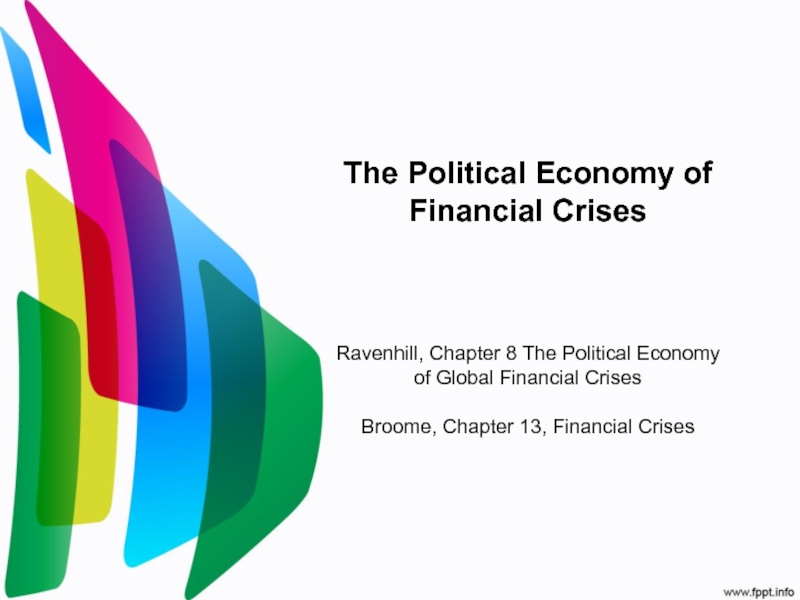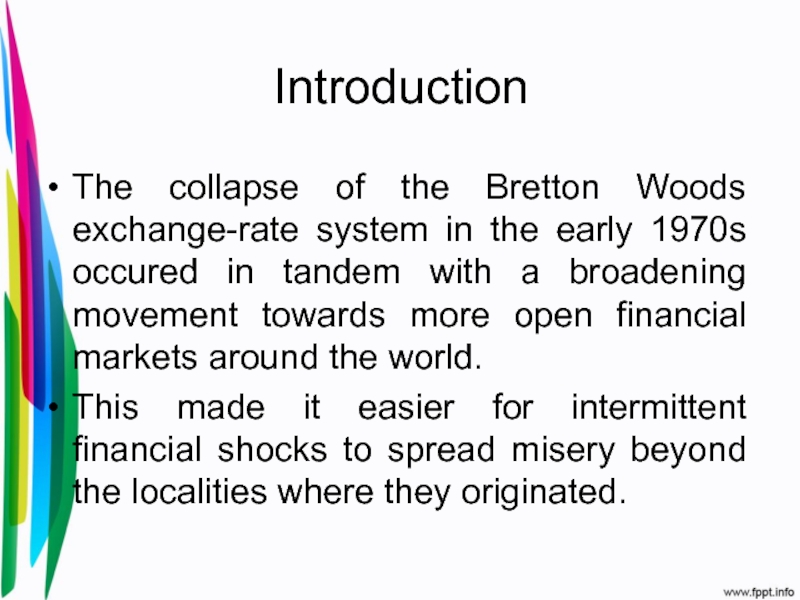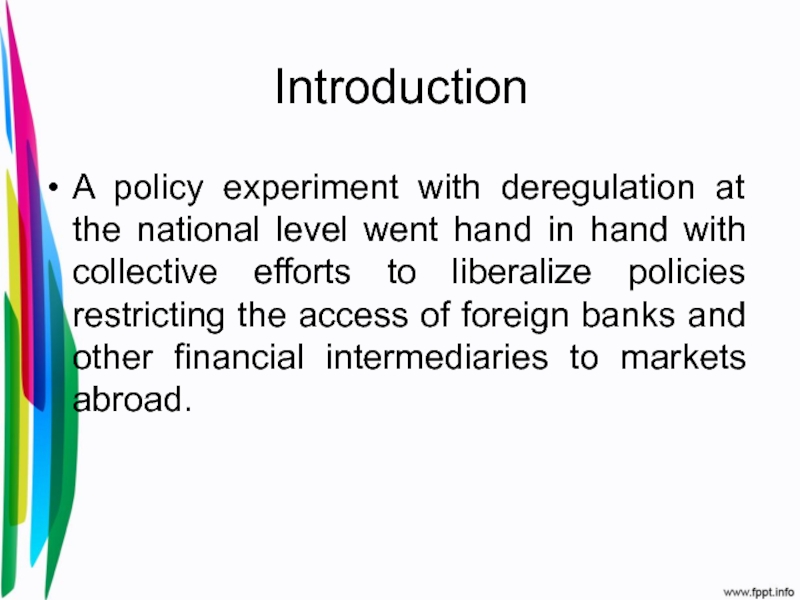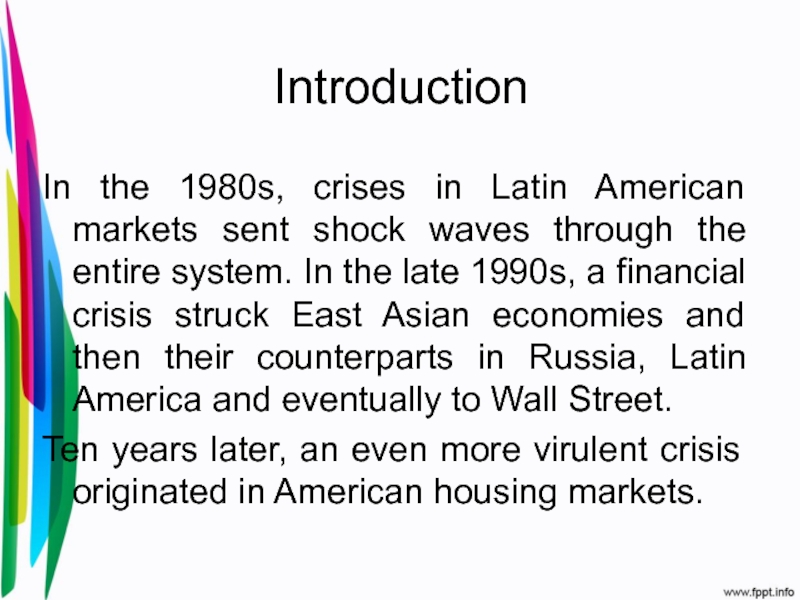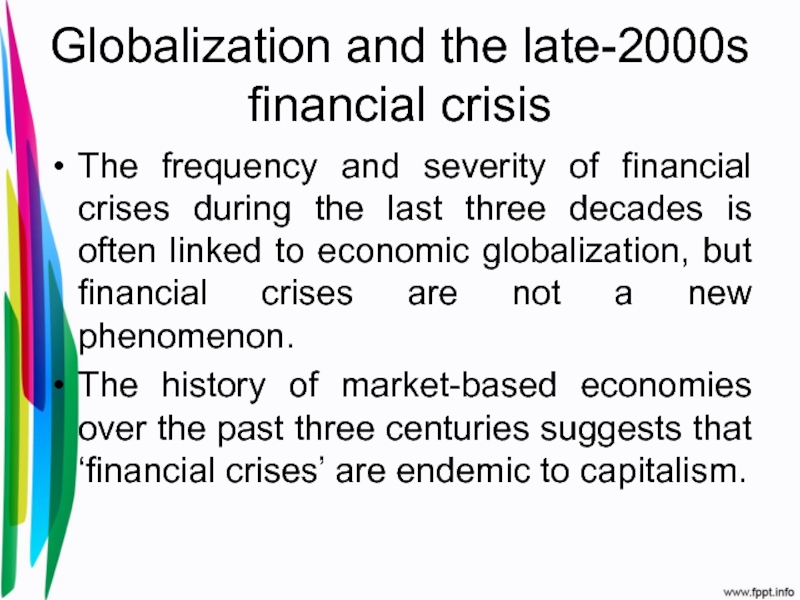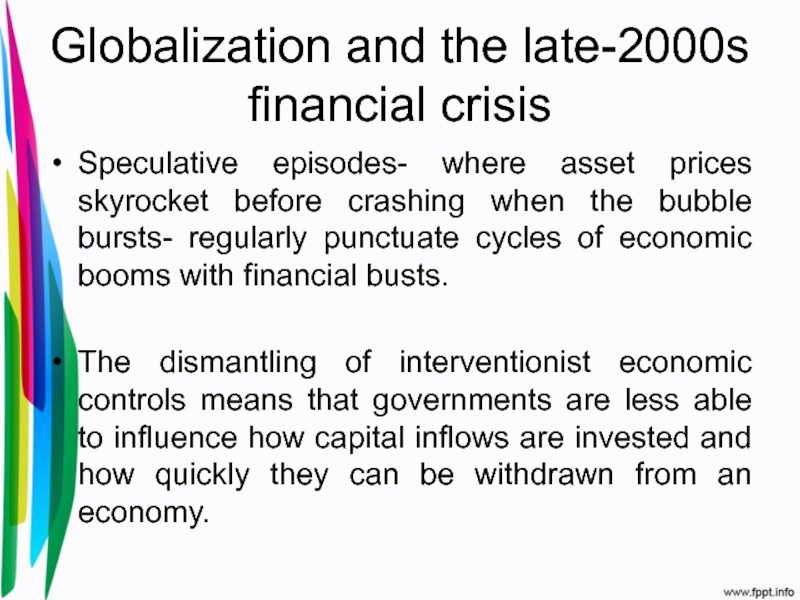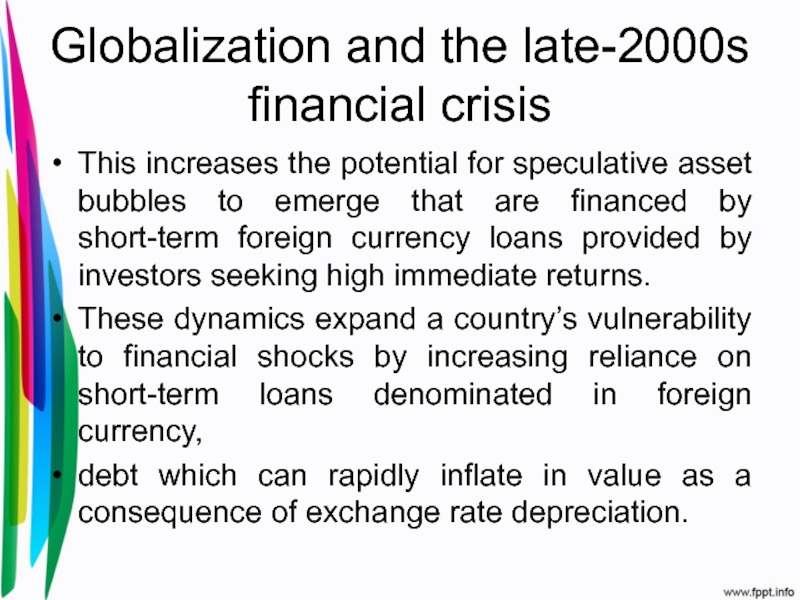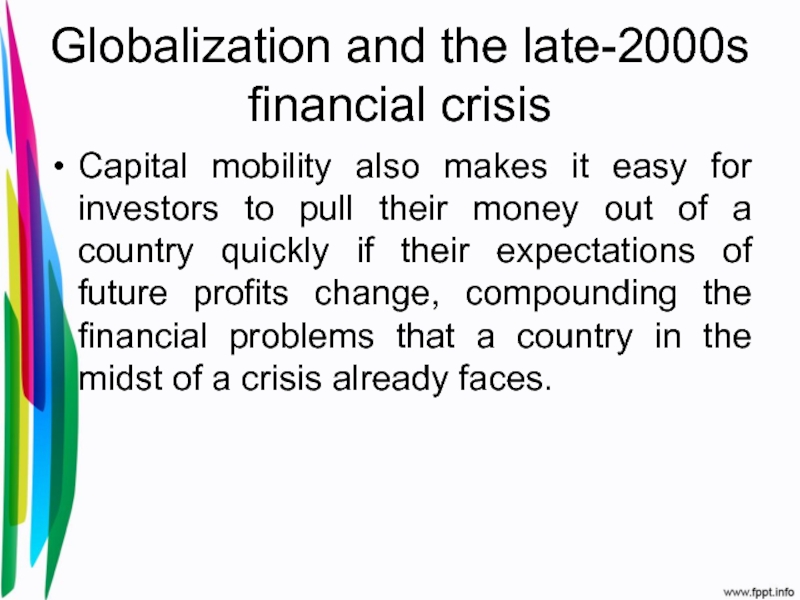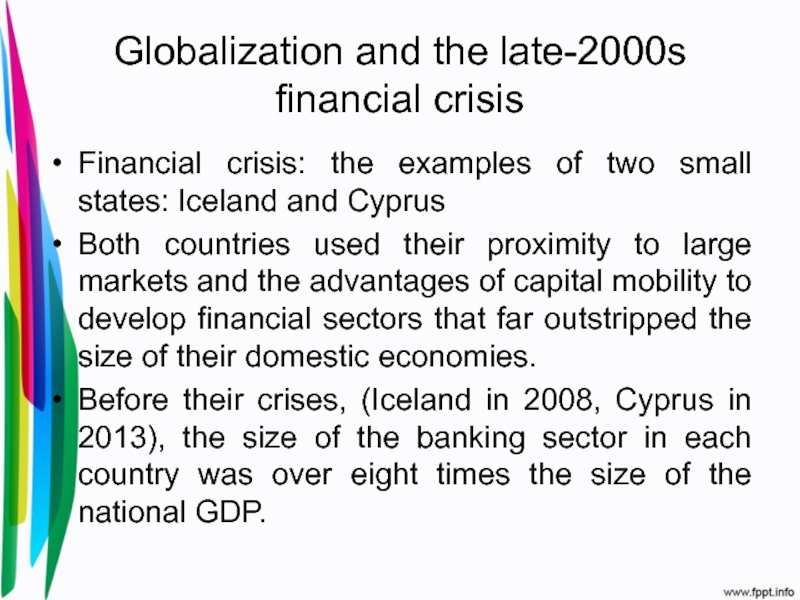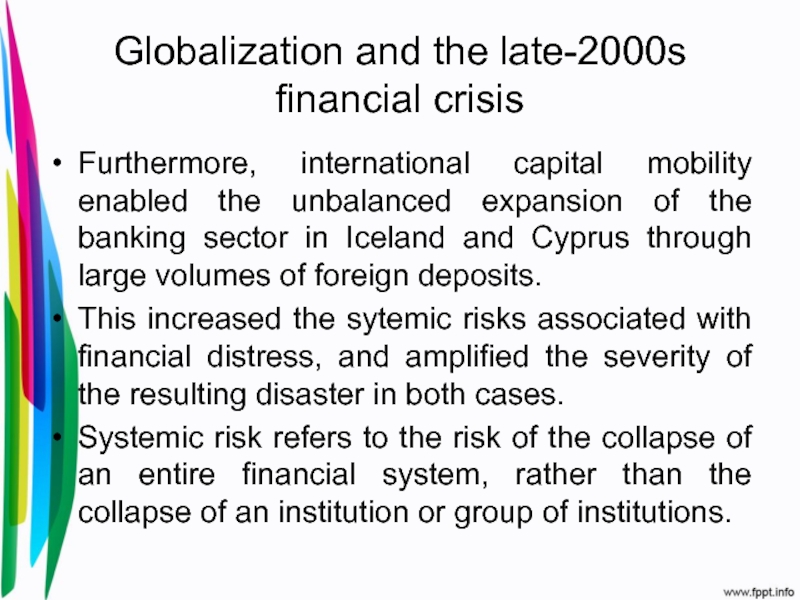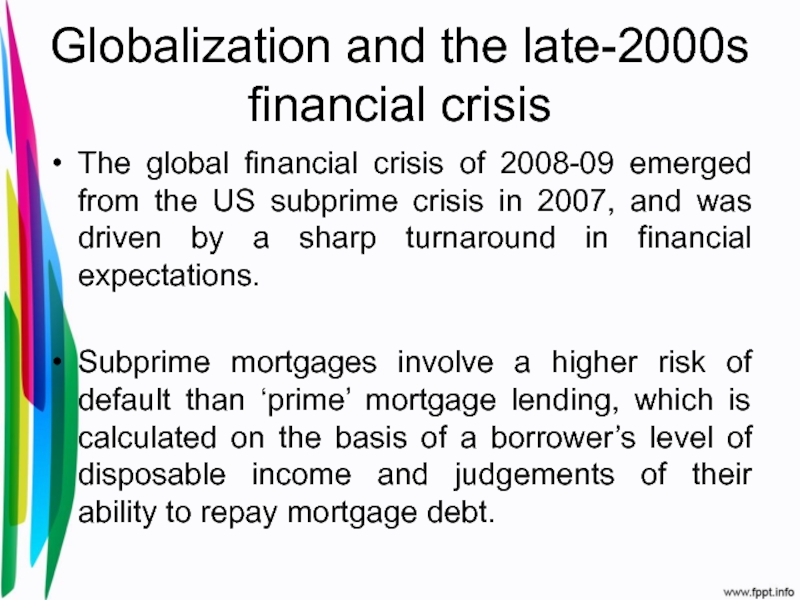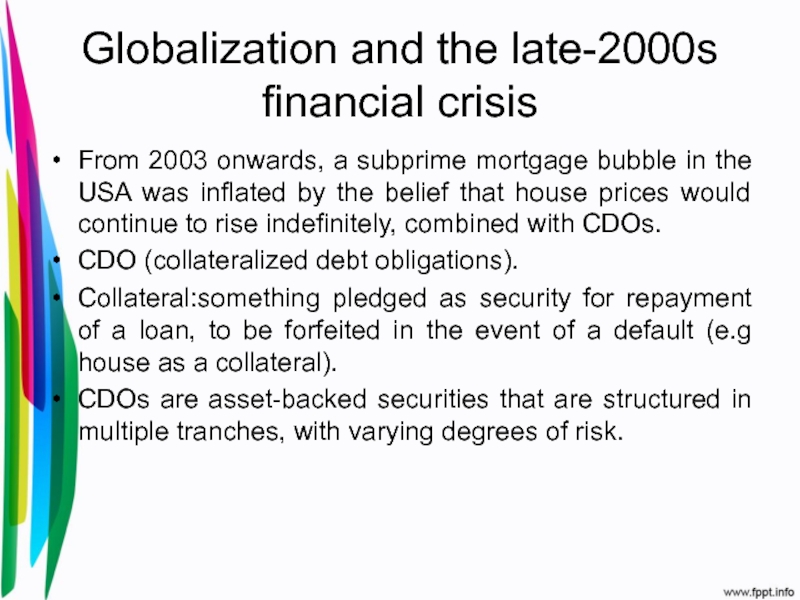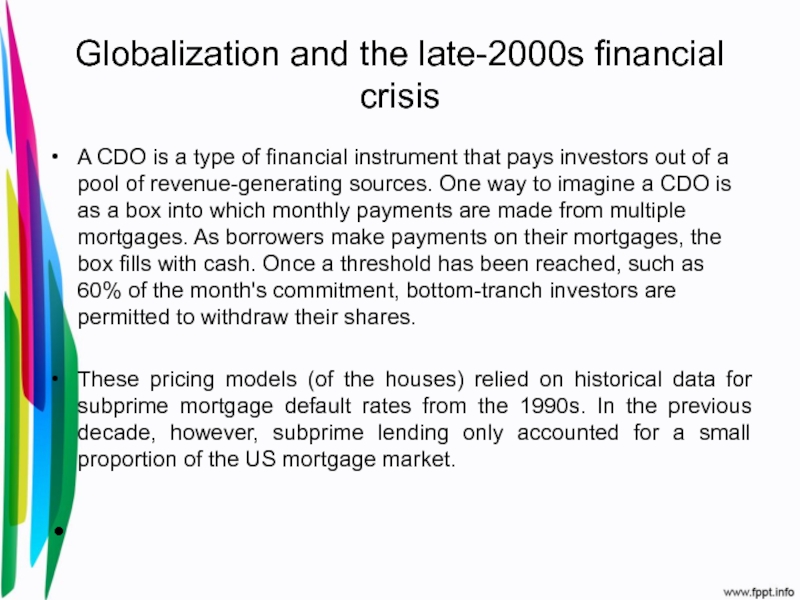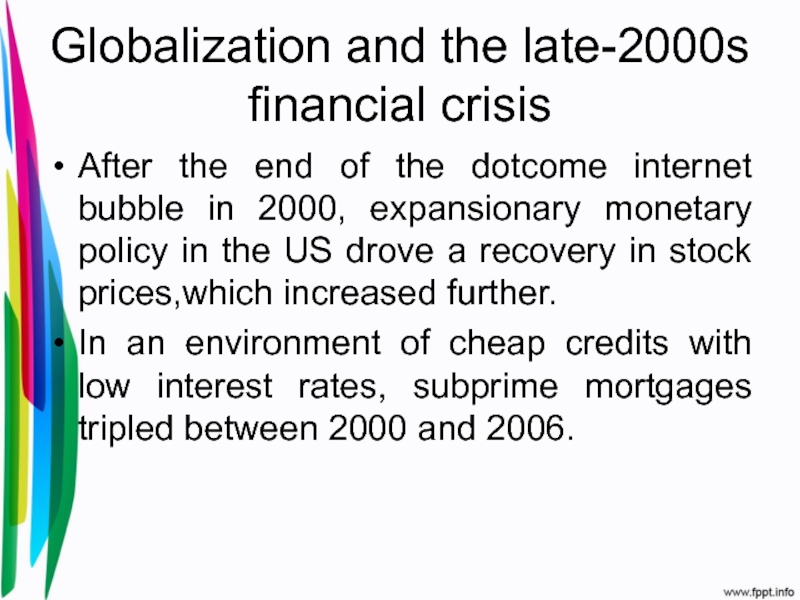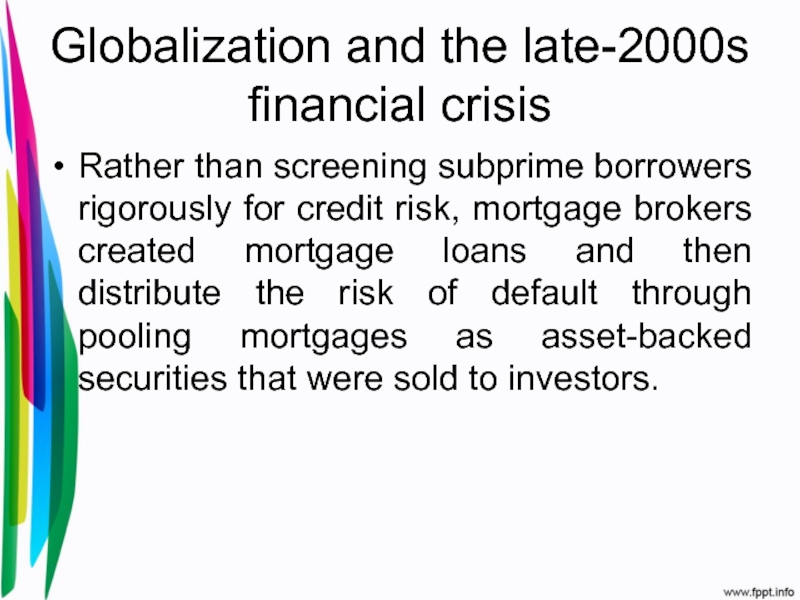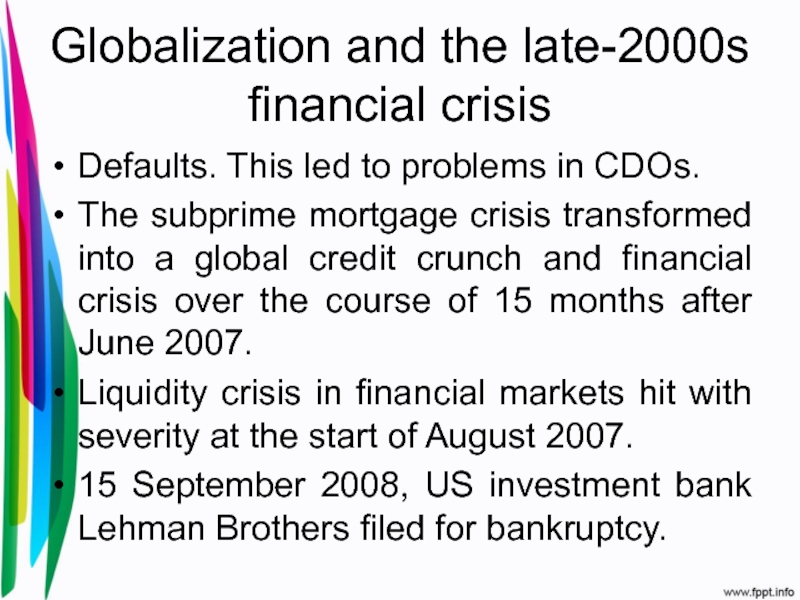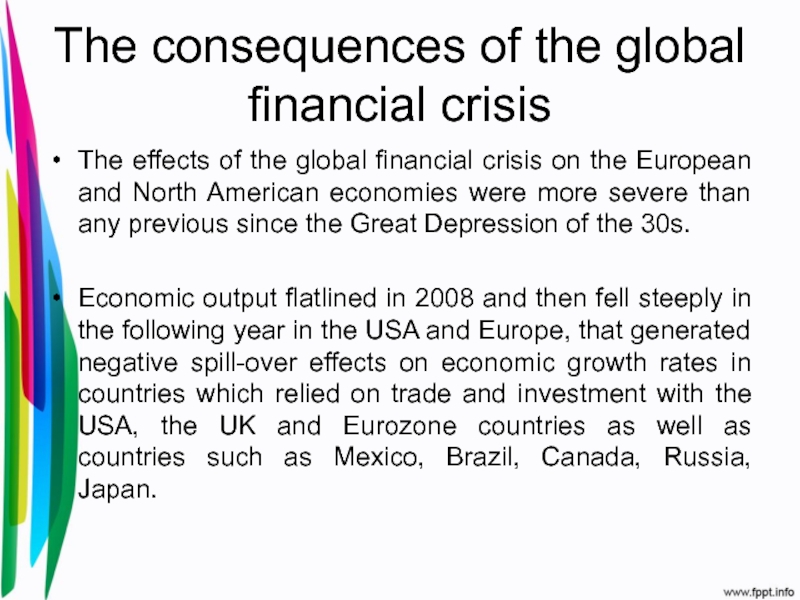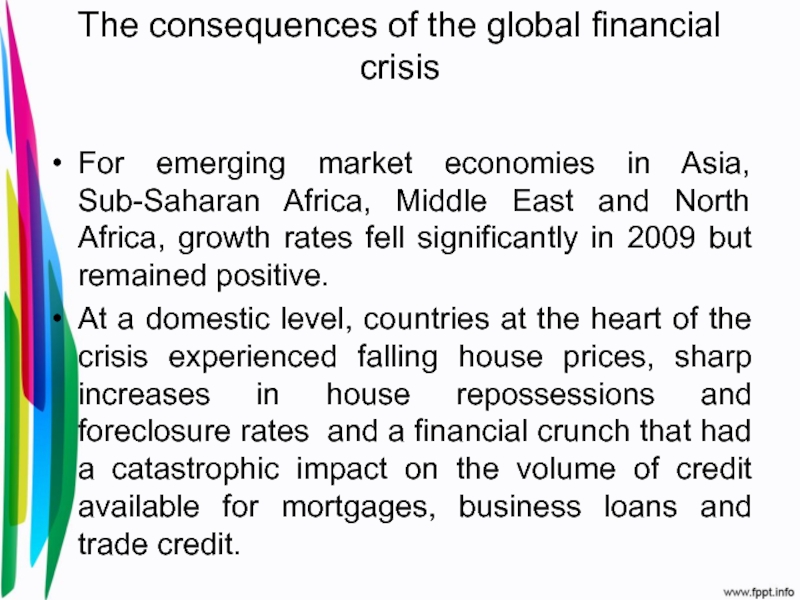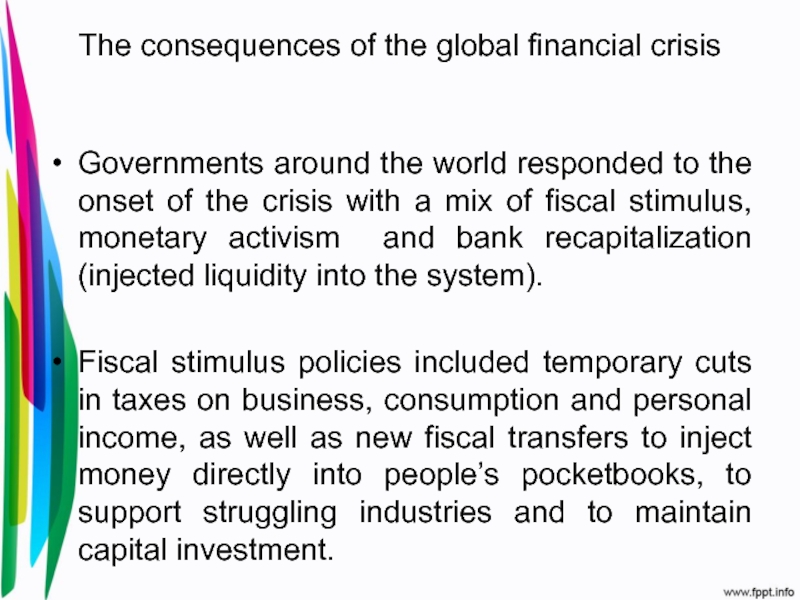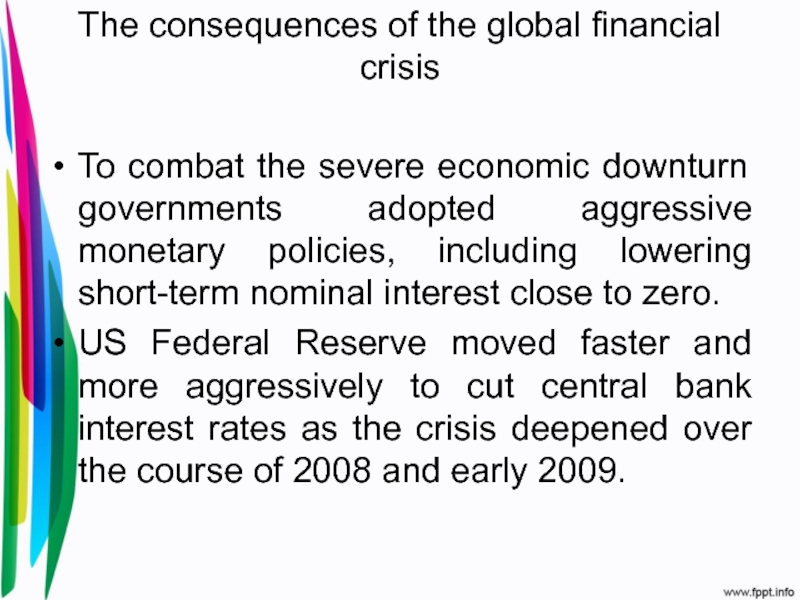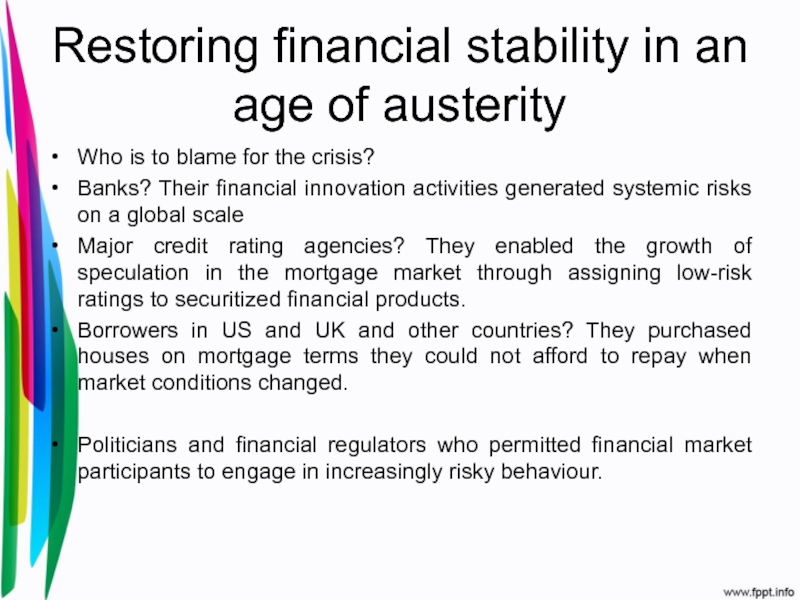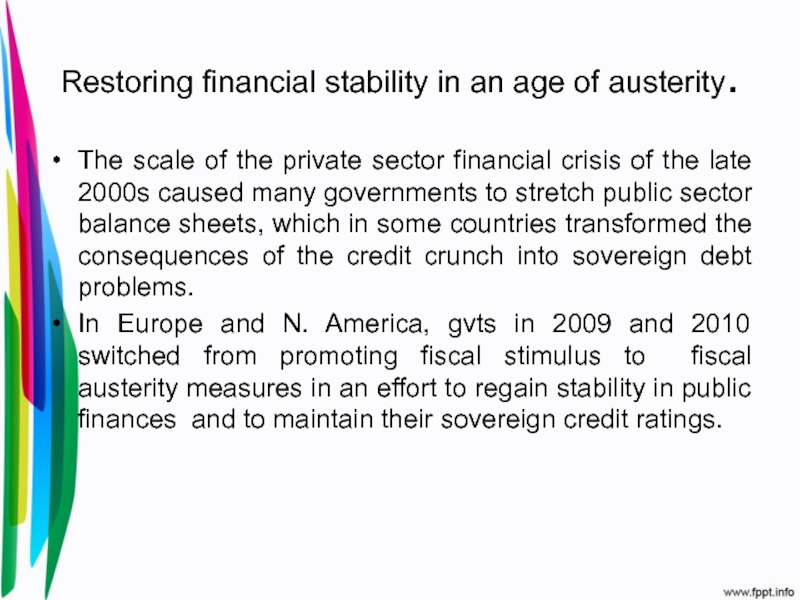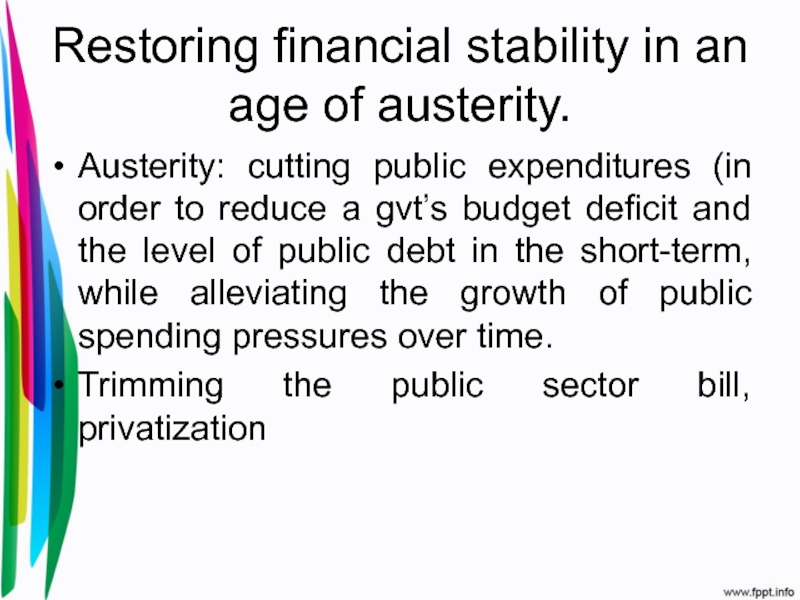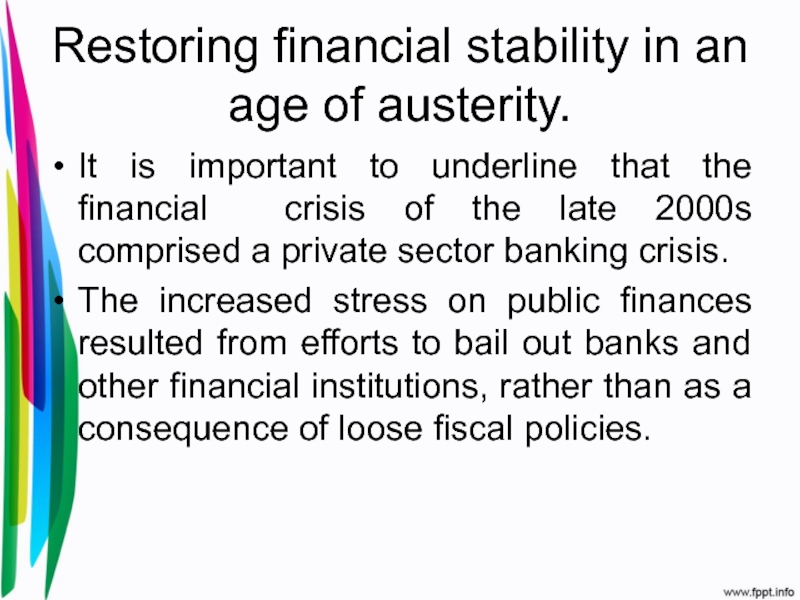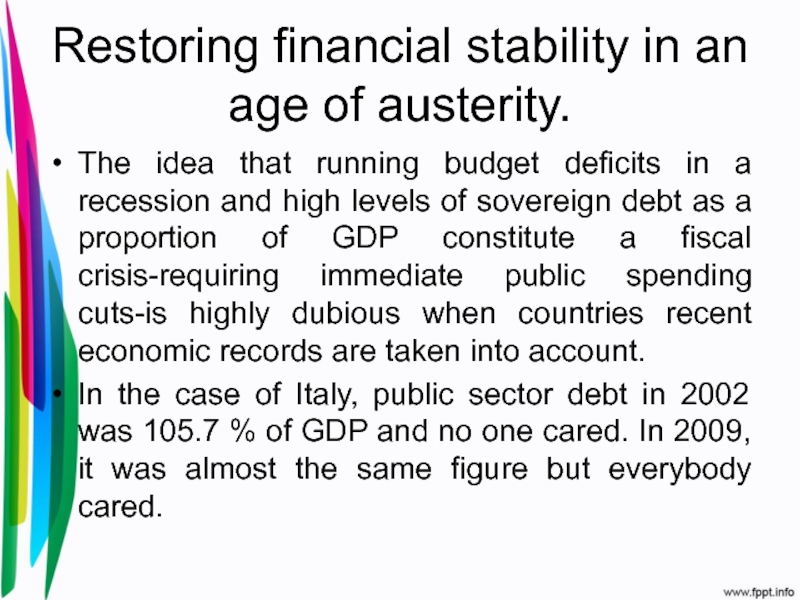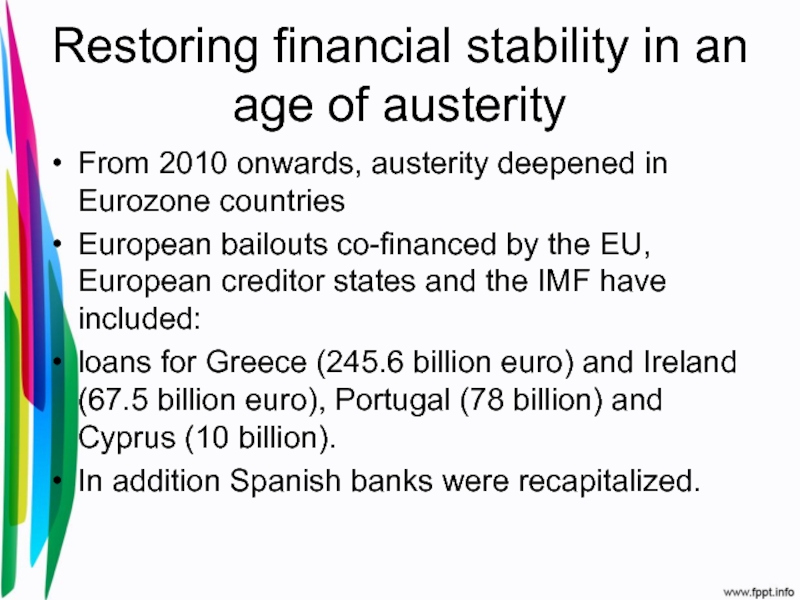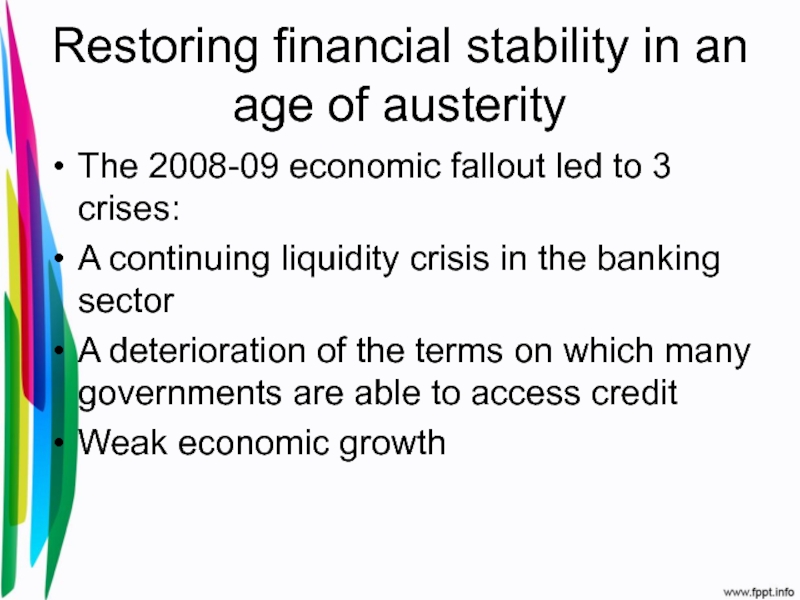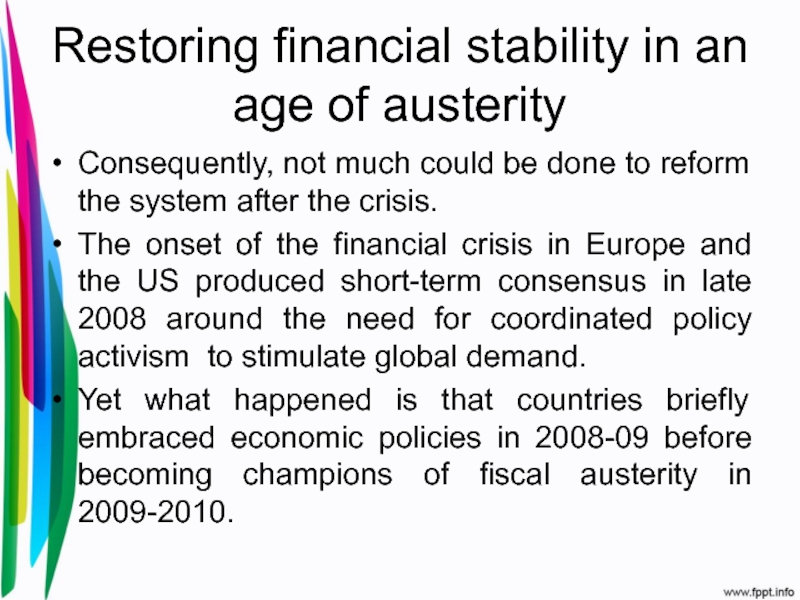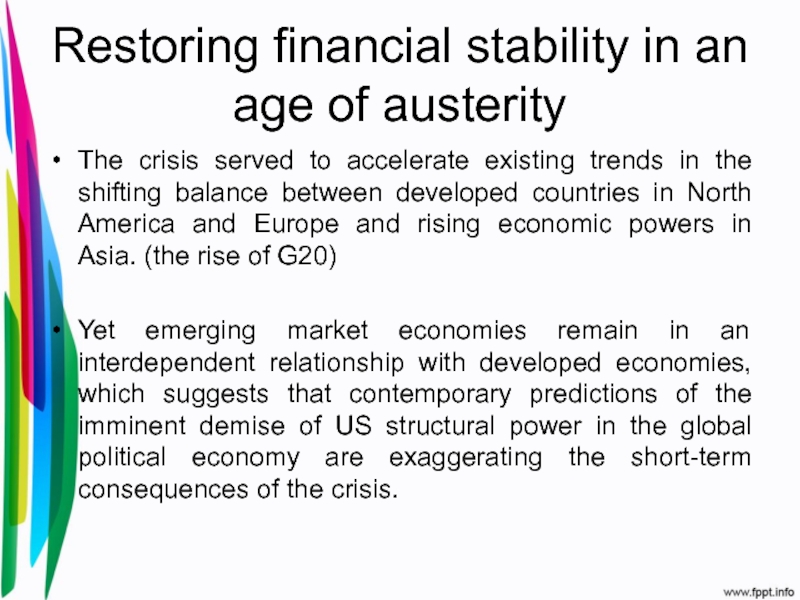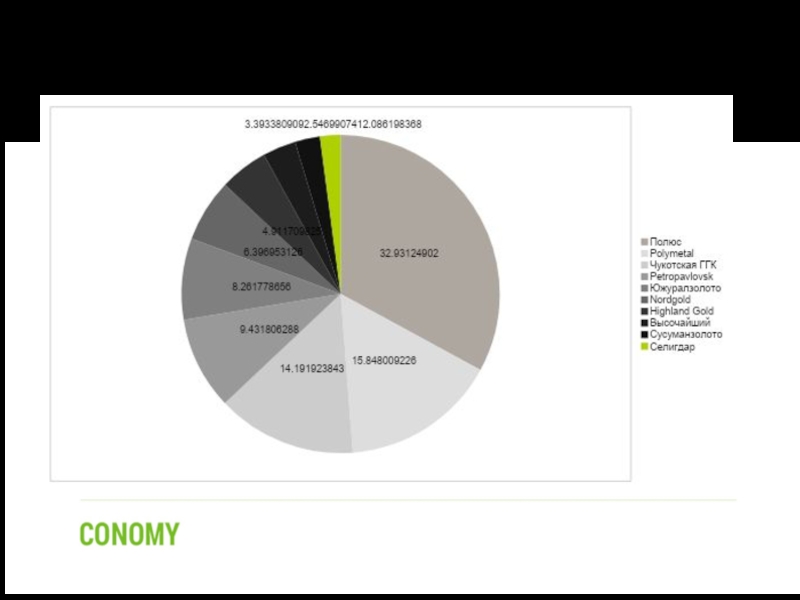of Global Financial Crises
Broome, Chapter 13, Financial Crises
- Главная
- Разное
- Дизайн
- Бизнес и предпринимательство
- Аналитика
- Образование
- Развлечения
- Красота и здоровье
- Финансы
- Государство
- Путешествия
- Спорт
- Недвижимость
- Армия
- Графика
- Культурология
- Еда и кулинария
- Лингвистика
- Английский язык
- Астрономия
- Алгебра
- Биология
- География
- Детские презентации
- Информатика
- История
- Литература
- Маркетинг
- Математика
- Медицина
- Менеджмент
- Музыка
- МХК
- Немецкий язык
- ОБЖ
- Обществознание
- Окружающий мир
- Педагогика
- Русский язык
- Технология
- Физика
- Философия
- Химия
- Шаблоны, картинки для презентаций
- Экология
- Экономика
- Юриспруденция
The political economy of global financial crises Broome, financial crises презентация
Содержание
- 1. The political economy of global financial crises Broome, financial crises
- 2. Introduction The collapse of the Bretton Woods
- 3. Introduction A policy experiment with deregulation at
- 4. Introduction In the 1980s, crises in Latin
- 5. Globalization and the late-2000s financial crisis The
- 6. Globalization and the late-2000s financial crisis Speculative
- 7. Globalization and the late-2000s financial crisis This
- 8. Globalization and the late-2000s financial crisis Capital
- 9. Globalization and the late-2000s financial crisis Financial
- 10. Globalization and the late-2000s financial crisis Furthermore,
- 11. Globalization and the late-2000s financial crisis The
- 12. Globalization and the late-2000s financial crisis From
- 13. Globalization and the late-2000s financial crisis A
- 14. Globalization and the late-2000s financial crisis After
- 15. Globalization and the late-2000s financial crisis Rather
- 16. Globalization and the late-2000s financial crisis Defaults.
- 17. Globalization and the late-2000s financial crisis The
- 18. The consequences of the global financial crisis
- 19. The consequences of the global financial crisis
- 20. The consequences of the global financial crisis
- 21. The consequences of the global financial crisis
- 22. Restoring financial stability in an age of
- 23. Restoring financial stability in an age of
- 24. Restoring financial stability in an age of
- 25. Restoring financial stability in an age of
- 26. Restoring financial stability in an age of
- 27. Restoring financial stability in an age of
- 28. Restoring financial stability in an age of
- 29. Restoring financial stability in an age of
- 30. Restoring financial stability in an age of
Слайд 2Introduction
The collapse of the Bretton Woods exchange-rate system in the early
1970s occured in tandem with a broadening movement towards more open financial markets around the world.
This made it easier for intermittent financial shocks to spread misery beyond the localities where they originated.
This made it easier for intermittent financial shocks to spread misery beyond the localities where they originated.
Слайд 3Introduction
A policy experiment with deregulation at the national level went hand
in hand with collective efforts to liberalize policies restricting the access of foreign banks and other financial intermediaries to markets abroad.
Слайд 4Introduction
In the 1980s, crises in Latin American markets sent shock waves
through the entire system. In the late 1990s, a financial crisis struck East Asian economies and then their counterparts in Russia, Latin America and eventually to Wall Street.
Ten years later, an even more virulent crisis originated in American housing markets.
Ten years later, an even more virulent crisis originated in American housing markets.
Слайд 5Globalization and the late-2000s financial crisis
The frequency and severity of financial
crises during the last three decades is often linked to economic globalization, but financial crises are not a new phenomenon.
The history of market-based economies over the past three centuries suggests that ‘financial crises’ are endemic to capitalism.
The history of market-based economies over the past three centuries suggests that ‘financial crises’ are endemic to capitalism.
Слайд 6Globalization and the late-2000s financial crisis
Speculative episodes- where asset prices skyrocket
before crashing when the bubble bursts- regularly punctuate cycles of economic booms with financial busts.
The dismantling of interventionist economic controls means that governments are less able to influence how capital inflows are invested and how quickly they can be withdrawn from an economy.
The dismantling of interventionist economic controls means that governments are less able to influence how capital inflows are invested and how quickly they can be withdrawn from an economy.
Слайд 7Globalization and the late-2000s financial crisis
This increases the potential for speculative
asset bubbles to emerge that are financed by short-term foreign currency loans provided by investors seeking high immediate returns.
These dynamics expand a country’s vulnerability to financial shocks by increasing reliance on short-term loans denominated in foreign currency,
debt which can rapidly inflate in value as a consequence of exchange rate depreciation.
These dynamics expand a country’s vulnerability to financial shocks by increasing reliance on short-term loans denominated in foreign currency,
debt which can rapidly inflate in value as a consequence of exchange rate depreciation.
Слайд 8Globalization and the late-2000s financial crisis
Capital mobility also makes it easy
for investors to pull their money out of a country quickly if their expectations of future profits change, compounding the financial problems that a country in the midst of a crisis already faces.
Слайд 9Globalization and the late-2000s financial crisis
Financial crisis: the examples of two
small states: Iceland and Cyprus
Both countries used their proximity to large markets and the advantages of capital mobility to develop financial sectors that far outstripped the size of their domestic economies.
Before their crises, (Iceland in 2008, Cyprus in 2013), the size of the banking sector in each country was over eight times the size of the national GDP.
Both countries used their proximity to large markets and the advantages of capital mobility to develop financial sectors that far outstripped the size of their domestic economies.
Before their crises, (Iceland in 2008, Cyprus in 2013), the size of the banking sector in each country was over eight times the size of the national GDP.
Слайд 10Globalization and the late-2000s financial crisis
Furthermore, international capital mobility enabled the
unbalanced expansion of the banking sector in Iceland and Cyprus through large volumes of foreign deposits.
This increased the sytemic risks associated with financial distress, and amplified the severity of the resulting disaster in both cases.
Systemic risk refers to the risk of the collapse of an entire financial system, rather than the collapse of an institution or group of institutions.
This increased the sytemic risks associated with financial distress, and amplified the severity of the resulting disaster in both cases.
Systemic risk refers to the risk of the collapse of an entire financial system, rather than the collapse of an institution or group of institutions.
Слайд 11Globalization and the late-2000s financial crisis
The global financial crisis of 2008-09
emerged from the US subprime crisis in 2007, and was driven by a sharp turnaround in financial expectations.
Subprime mortgages involve a higher risk of default than ‘prime’ mortgage lending, which is calculated on the basis of a borrower’s level of disposable income and judgements of their ability to repay mortgage debt.
Subprime mortgages involve a higher risk of default than ‘prime’ mortgage lending, which is calculated on the basis of a borrower’s level of disposable income and judgements of their ability to repay mortgage debt.
Слайд 12Globalization and the late-2000s financial crisis
From 2003 onwards, a subprime mortgage
bubble in the USA was inflated by the belief that house prices would continue to rise indefinitely, combined with CDOs.
CDO (collateralized debt obligations).
Collateral:something pledged as security for repayment of a loan, to be forfeited in the event of a default (e.g house as a collateral).
CDOs are asset-backed securities that are structured in multiple tranches, with varying degrees of risk.
CDO (collateralized debt obligations).
Collateral:something pledged as security for repayment of a loan, to be forfeited in the event of a default (e.g house as a collateral).
CDOs are asset-backed securities that are structured in multiple tranches, with varying degrees of risk.
Слайд 13Globalization and the late-2000s financial crisis
A CDO is a type of
financial instrument that pays investors out of a pool of revenue-generating sources. One way to imagine a CDO is as a box into which monthly payments are made from multiple mortgages. As borrowers make payments on their mortgages, the box fills with cash. Once a threshold has been reached, such as 60% of the month's commitment, bottom-tranch investors are permitted to withdraw their shares.
These pricing models (of the houses) relied on historical data for subprime mortgage default rates from the 1990s. In the previous decade, however, subprime lending only accounted for a small proportion of the US mortgage market.
These pricing models (of the houses) relied on historical data for subprime mortgage default rates from the 1990s. In the previous decade, however, subprime lending only accounted for a small proportion of the US mortgage market.
Слайд 14Globalization and the late-2000s financial crisis
After the end of the dotcome
internet bubble in 2000, expansionary monetary policy in the US drove a recovery in stock prices,which increased further.
In an environment of cheap credits with low interest rates, subprime mortgages tripled between 2000 and 2006.
In an environment of cheap credits with low interest rates, subprime mortgages tripled between 2000 and 2006.
Слайд 15Globalization and the late-2000s financial crisis
Rather than screening subprime borrowers rigorously
for credit risk, mortgage brokers created mortgage loans and then distribute the risk of default through pooling mortgages as asset-backed securities that were sold to investors.
Слайд 16Globalization and the late-2000s financial crisis
Defaults. This led to problems in
CDOs.
The subprime mortgage crisis transformed into a global credit crunch and financial crisis over the course of 15 months after June 2007.
Liquidity crisis in financial markets hit with severity at the start of August 2007.
15 September 2008, US investment bank Lehman Brothers filed for bankruptcy.
The subprime mortgage crisis transformed into a global credit crunch and financial crisis over the course of 15 months after June 2007.
Liquidity crisis in financial markets hit with severity at the start of August 2007.
15 September 2008, US investment bank Lehman Brothers filed for bankruptcy.
Слайд 17Globalization and the late-2000s financial crisis
The collapse of the Lehman Brothers
is widely recognized as the trigger that transformed financial liquidity problems into a systemic crisis of the global financial system.
Слайд 18The consequences of the global financial crisis
The effects of the global
financial crisis on the European and North American economies were more severe than any previous since the Great Depression of the 30s.
Economic output flatlined in 2008 and then fell steeply in the following year in the USA and Europe, that generated negative spill-over effects on economic growth rates in countries which relied on trade and investment with the USA, the UK and Eurozone countries as well as countries such as Mexico, Brazil, Canada, Russia, Japan.
Economic output flatlined in 2008 and then fell steeply in the following year in the USA and Europe, that generated negative spill-over effects on economic growth rates in countries which relied on trade and investment with the USA, the UK and Eurozone countries as well as countries such as Mexico, Brazil, Canada, Russia, Japan.
Слайд 19The consequences of the global financial crisis
For emerging market economies in
Asia, Sub-Saharan Africa, Middle East and North Africa, growth rates fell significantly in 2009 but remained positive.
At a domestic level, countries at the heart of the crisis experienced falling house prices, sharp increases in house repossessions and foreclosure rates and a financial crunch that had a catastrophic impact on the volume of credit available for mortgages, business loans and trade credit.
At a domestic level, countries at the heart of the crisis experienced falling house prices, sharp increases in house repossessions and foreclosure rates and a financial crunch that had a catastrophic impact on the volume of credit available for mortgages, business loans and trade credit.
Слайд 20The consequences of the global financial crisis
Governments around the world responded
to the onset of the crisis with a mix of fiscal stimulus, monetary activism and bank recapitalization (injected liquidity into the system).
Fiscal stimulus policies included temporary cuts in taxes on business, consumption and personal income, as well as new fiscal transfers to inject money directly into people’s pocketbooks, to support struggling industries and to maintain capital investment.
Fiscal stimulus policies included temporary cuts in taxes on business, consumption and personal income, as well as new fiscal transfers to inject money directly into people’s pocketbooks, to support struggling industries and to maintain capital investment.
Слайд 21The consequences of the global financial crisis
To combat the severe economic
downturn governments adopted aggressive monetary policies, including lowering short-term nominal interest close to zero.
US Federal Reserve moved faster and more aggressively to cut central bank interest rates as the crisis deepened over the course of 2008 and early 2009.
US Federal Reserve moved faster and more aggressively to cut central bank interest rates as the crisis deepened over the course of 2008 and early 2009.
Слайд 22Restoring financial stability in an age of austerity
Who is to blame
for the crisis?
Banks? Their financial innovation activities generated systemic risks on a global scale
Major credit rating agencies? They enabled the growth of speculation in the mortgage market through assigning low-risk ratings to securitized financial products.
Borrowers in US and UK and other countries? They purchased houses on mortgage terms they could not afford to repay when market conditions changed.
Politicians and financial regulators who permitted financial market participants to engage in increasingly risky behaviour.
Banks? Their financial innovation activities generated systemic risks on a global scale
Major credit rating agencies? They enabled the growth of speculation in the mortgage market through assigning low-risk ratings to securitized financial products.
Borrowers in US and UK and other countries? They purchased houses on mortgage terms they could not afford to repay when market conditions changed.
Politicians and financial regulators who permitted financial market participants to engage in increasingly risky behaviour.
Слайд 23Restoring financial stability in an age of austerity.
The scale of the
private sector financial crisis of the late 2000s caused many governments to stretch public sector balance sheets, which in some countries transformed the consequences of the credit crunch into sovereign debt problems.
In Europe and N. America, gvts in 2009 and 2010 switched from promoting fiscal stimulus to fiscal austerity measures in an effort to regain stability in public finances and to maintain their sovereign credit ratings.
In Europe and N. America, gvts in 2009 and 2010 switched from promoting fiscal stimulus to fiscal austerity measures in an effort to regain stability in public finances and to maintain their sovereign credit ratings.
Слайд 24Restoring financial stability in an age of austerity.
Austerity: cutting public expenditures
(in order to reduce a gvt’s budget deficit and the level of public debt in the short-term, while alleviating the growth of public spending pressures over time.
Trimming the public sector bill, privatization
Trimming the public sector bill, privatization
Слайд 25Restoring financial stability in an age of austerity.
It is important to
underline that the financial crisis of the late 2000s comprised a private sector banking crisis.
The increased stress on public finances resulted from efforts to bail out banks and other financial institutions, rather than as a consequence of loose fiscal policies.
The increased stress on public finances resulted from efforts to bail out banks and other financial institutions, rather than as a consequence of loose fiscal policies.
Слайд 26Restoring financial stability in an age of austerity.
The idea that running
budget deficits in a recession and high levels of sovereign debt as a proportion of GDP constitute a fiscal crisis-requiring immediate public spending cuts-is highly dubious when countries recent economic records are taken into account.
In the case of Italy, public sector debt in 2002 was 105.7 % of GDP and no one cared. In 2009, it was almost the same figure but everybody cared.
In the case of Italy, public sector debt in 2002 was 105.7 % of GDP and no one cared. In 2009, it was almost the same figure but everybody cared.
Слайд 27Restoring financial stability in an age of austerity
From 2010 onwards, austerity
deepened in Eurozone countries
European bailouts co-financed by the EU, European creditor states and the IMF have included:
loans for Greece (245.6 billion euro) and Ireland (67.5 billion euro), Portugal (78 billion) and Cyprus (10 billion).
In addition Spanish banks were recapitalized.
European bailouts co-financed by the EU, European creditor states and the IMF have included:
loans for Greece (245.6 billion euro) and Ireland (67.5 billion euro), Portugal (78 billion) and Cyprus (10 billion).
In addition Spanish banks were recapitalized.
Слайд 28Restoring financial stability in an age of austerity
The 2008-09 economic fallout
led to 3 crises:
A continuing liquidity crisis in the banking sector
A deterioration of the terms on which many governments are able to access credit
Weak economic growth
A continuing liquidity crisis in the banking sector
A deterioration of the terms on which many governments are able to access credit
Weak economic growth
Слайд 29Restoring financial stability in an age of austerity
Consequently, not much could
be done to reform the system after the crisis.
The onset of the financial crisis in Europe and the US produced short-term consensus in late 2008 around the need for coordinated policy activism to stimulate global demand.
Yet what happened is that countries briefly embraced economic policies in 2008-09 before becoming champions of fiscal austerity in 2009-2010.
The onset of the financial crisis in Europe and the US produced short-term consensus in late 2008 around the need for coordinated policy activism to stimulate global demand.
Yet what happened is that countries briefly embraced economic policies in 2008-09 before becoming champions of fiscal austerity in 2009-2010.
Слайд 30Restoring financial stability in an age of austerity
The crisis served to
accelerate existing trends in the shifting balance between developed countries in North America and Europe and rising economic powers in Asia. (the rise of G20)
Yet emerging market economies remain in an interdependent relationship with developed economies, which suggests that contemporary predictions of the imminent demise of US structural power in the global political economy are exaggerating the short-term consequences of the crisis.
Yet emerging market economies remain in an interdependent relationship with developed economies, which suggests that contemporary predictions of the imminent demise of US structural power in the global political economy are exaggerating the short-term consequences of the crisis.
